Critical Appraisal of Evidence on Drug Use in Music Festivals
VerifiedAdded on 2022/12/28
|10
|2259
|75
AI Summary
This article provides a critical appraisal of the evidence on drug use in music festivals, including knowledge and practices regarding drug content and purity. It examines the research questions, methodology, results, and limitations of a cross-sectional survey conducted by Day et al. (2018). The study aims to increase understanding of the interrelation between drug abuse and music festivals.
Contribute Materials
Your contribution can guide someone’s learning journey. Share your
documents today.

Page 0 of 10
CRITICAL APPRAISAL ASSIGNMENT
Student name:
Student number:
HLSC122Semester1, 2019
Assessment 3: Critical appraisal of evidence
Word count: 1574
Student name/student number
CRITICAL APPRAISAL ASSIGNMENT
Student name:
Student number:
HLSC122Semester1, 2019
Assessment 3: Critical appraisal of evidence
Word count: 1574
Student name/student number
Secure Best Marks with AI Grader
Need help grading? Try our AI Grader for instant feedback on your assignments.
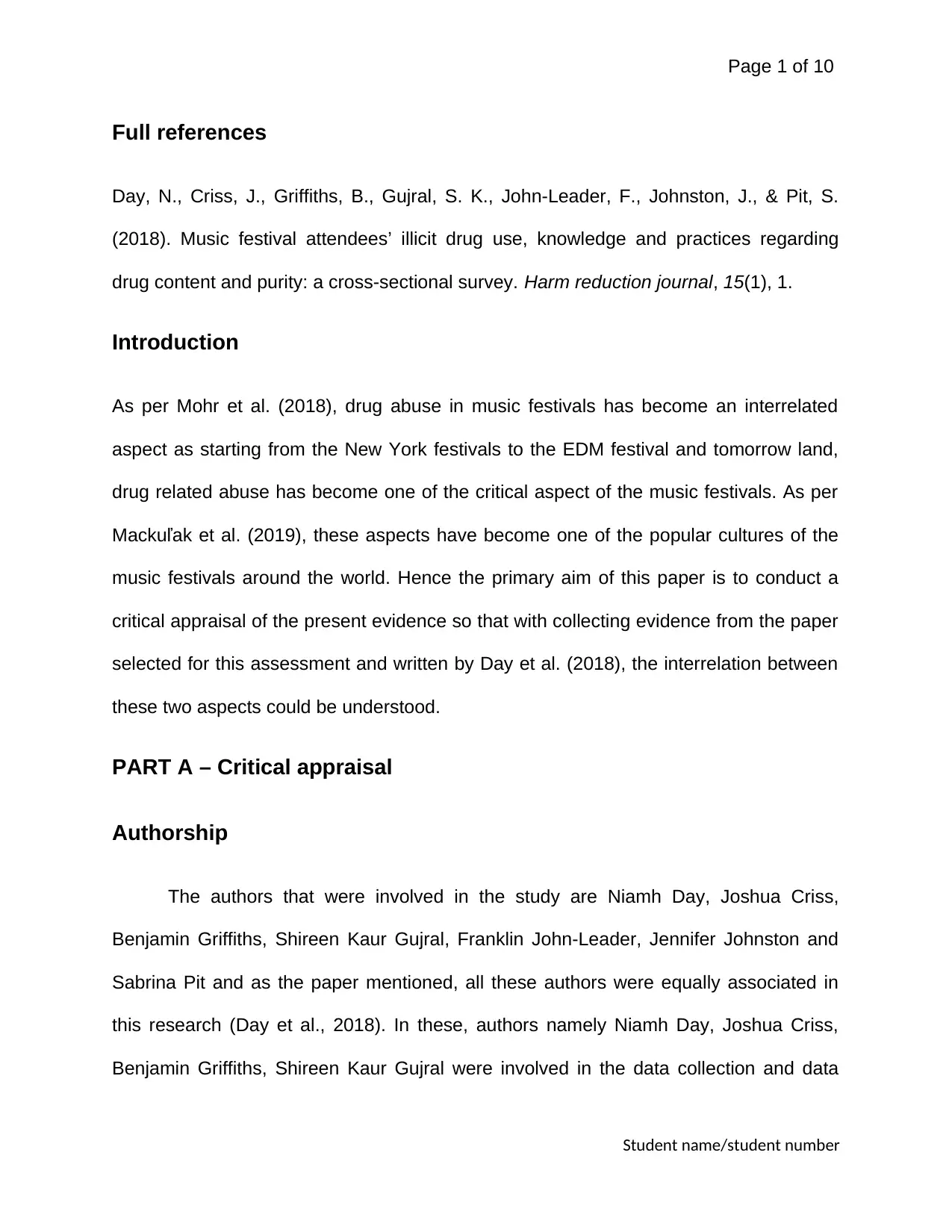
Page 1 of 10
Full references
Day, N., Criss, J., Griffiths, B., Gujral, S. K., John-Leader, F., Johnston, J., & Pit, S.
(2018). Music festival attendees’ illicit drug use, knowledge and practices regarding
drug content and purity: a cross-sectional survey. Harm reduction journal, 15(1), 1.
Introduction
As per Mohr et al. (2018), drug abuse in music festivals has become an interrelated
aspect as starting from the New York festivals to the EDM festival and tomorrow land,
drug related abuse has become one of the critical aspect of the music festivals. As per
Mackuľak et al. (2019), these aspects have become one of the popular cultures of the
music festivals around the world. Hence the primary aim of this paper is to conduct a
critical appraisal of the present evidence so that with collecting evidence from the paper
selected for this assessment and written by Day et al. (2018), the interrelation between
these two aspects could be understood.
PART A – Critical appraisal
Authorship
The authors that were involved in the study are Niamh Day, Joshua Criss,
Benjamin Griffiths, Shireen Kaur Gujral, Franklin John-Leader, Jennifer Johnston and
Sabrina Pit and as the paper mentioned, all these authors were equally associated in
this research (Day et al., 2018). In these, authors namely Niamh Day, Joshua Criss,
Benjamin Griffiths, Shireen Kaur Gujral were involved in the data collection and data
Student name/student number
Full references
Day, N., Criss, J., Griffiths, B., Gujral, S. K., John-Leader, F., Johnston, J., & Pit, S.
(2018). Music festival attendees’ illicit drug use, knowledge and practices regarding
drug content and purity: a cross-sectional survey. Harm reduction journal, 15(1), 1.
Introduction
As per Mohr et al. (2018), drug abuse in music festivals has become an interrelated
aspect as starting from the New York festivals to the EDM festival and tomorrow land,
drug related abuse has become one of the critical aspect of the music festivals. As per
Mackuľak et al. (2019), these aspects have become one of the popular cultures of the
music festivals around the world. Hence the primary aim of this paper is to conduct a
critical appraisal of the present evidence so that with collecting evidence from the paper
selected for this assessment and written by Day et al. (2018), the interrelation between
these two aspects could be understood.
PART A – Critical appraisal
Authorship
The authors that were involved in the study are Niamh Day, Joshua Criss,
Benjamin Griffiths, Shireen Kaur Gujral, Franklin John-Leader, Jennifer Johnston and
Sabrina Pit and as the paper mentioned, all these authors were equally associated in
this research (Day et al., 2018). In these, authors namely Niamh Day, Joshua Criss,
Benjamin Griffiths, Shireen Kaur Gujral were involved in the data collection and data
Student name/student number
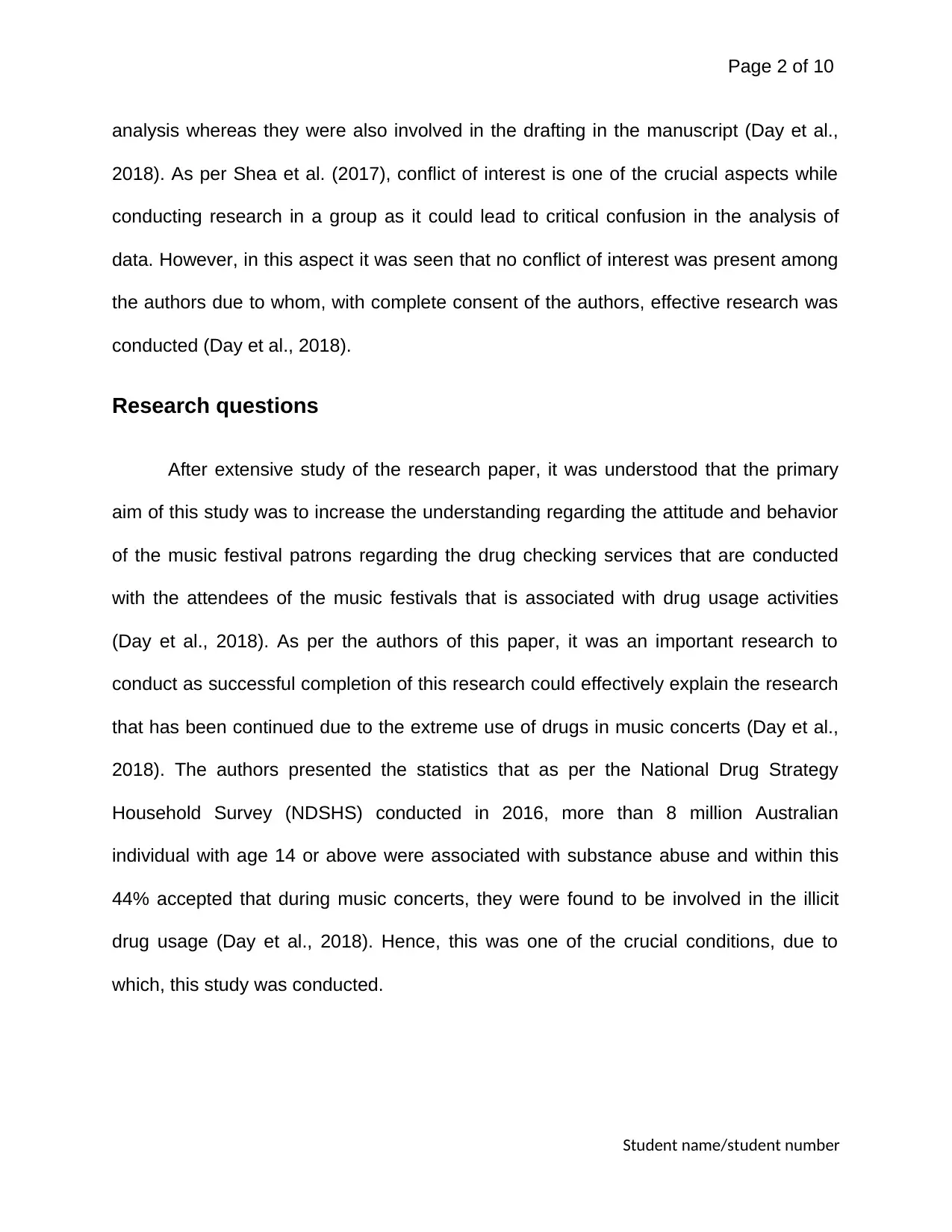
Page 2 of 10
analysis whereas they were also involved in the drafting in the manuscript (Day et al.,
2018). As per Shea et al. (2017), conflict of interest is one of the crucial aspects while
conducting research in a group as it could lead to critical confusion in the analysis of
data. However, in this aspect it was seen that no conflict of interest was present among
the authors due to whom, with complete consent of the authors, effective research was
conducted (Day et al., 2018).
Research questions
After extensive study of the research paper, it was understood that the primary
aim of this study was to increase the understanding regarding the attitude and behavior
of the music festival patrons regarding the drug checking services that are conducted
with the attendees of the music festivals that is associated with drug usage activities
(Day et al., 2018). As per the authors of this paper, it was an important research to
conduct as successful completion of this research could effectively explain the research
that has been continued due to the extreme use of drugs in music concerts (Day et al.,
2018). The authors presented the statistics that as per the National Drug Strategy
Household Survey (NDSHS) conducted in 2016, more than 8 million Australian
individual with age 14 or above were associated with substance abuse and within this
44% accepted that during music concerts, they were found to be involved in the illicit
drug usage (Day et al., 2018). Hence, this was one of the crucial conditions, due to
which, this study was conducted.
Student name/student number
analysis whereas they were also involved in the drafting in the manuscript (Day et al.,
2018). As per Shea et al. (2017), conflict of interest is one of the crucial aspects while
conducting research in a group as it could lead to critical confusion in the analysis of
data. However, in this aspect it was seen that no conflict of interest was present among
the authors due to whom, with complete consent of the authors, effective research was
conducted (Day et al., 2018).
Research questions
After extensive study of the research paper, it was understood that the primary
aim of this study was to increase the understanding regarding the attitude and behavior
of the music festival patrons regarding the drug checking services that are conducted
with the attendees of the music festivals that is associated with drug usage activities
(Day et al., 2018). As per the authors of this paper, it was an important research to
conduct as successful completion of this research could effectively explain the research
that has been continued due to the extreme use of drugs in music concerts (Day et al.,
2018). The authors presented the statistics that as per the National Drug Strategy
Household Survey (NDSHS) conducted in 2016, more than 8 million Australian
individual with age 14 or above were associated with substance abuse and within this
44% accepted that during music concerts, they were found to be involved in the illicit
drug usage (Day et al., 2018). Hence, this was one of the crucial conditions, due to
which, this study was conducted.
Student name/student number

Page 3 of 10
Research questions
For the conduction of the research, the researchers conducted a quantitative
research and in this process, they conducted a cross sectional survey so that all the
attendees of the music concerts could be allowed in the conduction of the survey and
through their response, the research data could be analyzed (Day et al., 2018). Prior to
include all the participants in the research study, they were asked about their
demographics, their personal stands about drug checking in the music festivals and
then their history of illicit drug use. Hence after confirming their eligibility for the
research process, they were taken into consideration for their involvement in the survey
process (Day et al., 2018). After this, it was mentioned in the research that in this
quantitative research, the participants were asked few open ended questions so that
they could express on the questions depending upon their own experience (Day et al.,
2018). The research was conducted in a famous music concert of Australia for two days
and total attendees that were involved in the survey were 642 and the age group that
was present mostly in the process was between 18 to 30 years. Finally, after the
collection of the data, a descriptive analysis was conducted so that with effective
analysis the research question could be addressed (Day et al., 2018). It should be
mentioned that to maintain the integrity of the responses, no incentive were provided to
the participants and all the participants were contacted in day time so that they could be
questioned in intoxicated state and the connection was developed as an independent
healthcare worker not through any governmental or public healthcare campaign so that
the authenticity of the research could be maintained (Day et al., 2018).
Student name/student number
Research questions
For the conduction of the research, the researchers conducted a quantitative
research and in this process, they conducted a cross sectional survey so that all the
attendees of the music concerts could be allowed in the conduction of the survey and
through their response, the research data could be analyzed (Day et al., 2018). Prior to
include all the participants in the research study, they were asked about their
demographics, their personal stands about drug checking in the music festivals and
then their history of illicit drug use. Hence after confirming their eligibility for the
research process, they were taken into consideration for their involvement in the survey
process (Day et al., 2018). After this, it was mentioned in the research that in this
quantitative research, the participants were asked few open ended questions so that
they could express on the questions depending upon their own experience (Day et al.,
2018). The research was conducted in a famous music concert of Australia for two days
and total attendees that were involved in the survey were 642 and the age group that
was present mostly in the process was between 18 to 30 years. Finally, after the
collection of the data, a descriptive analysis was conducted so that with effective
analysis the research question could be addressed (Day et al., 2018). It should be
mentioned that to maintain the integrity of the responses, no incentive were provided to
the participants and all the participants were contacted in day time so that they could be
questioned in intoxicated state and the connection was developed as an independent
healthcare worker not through any governmental or public healthcare campaign so that
the authenticity of the research could be maintained (Day et al., 2018).
Student name/student number
Secure Best Marks with AI Grader
Need help grading? Try our AI Grader for instant feedback on your assignments.
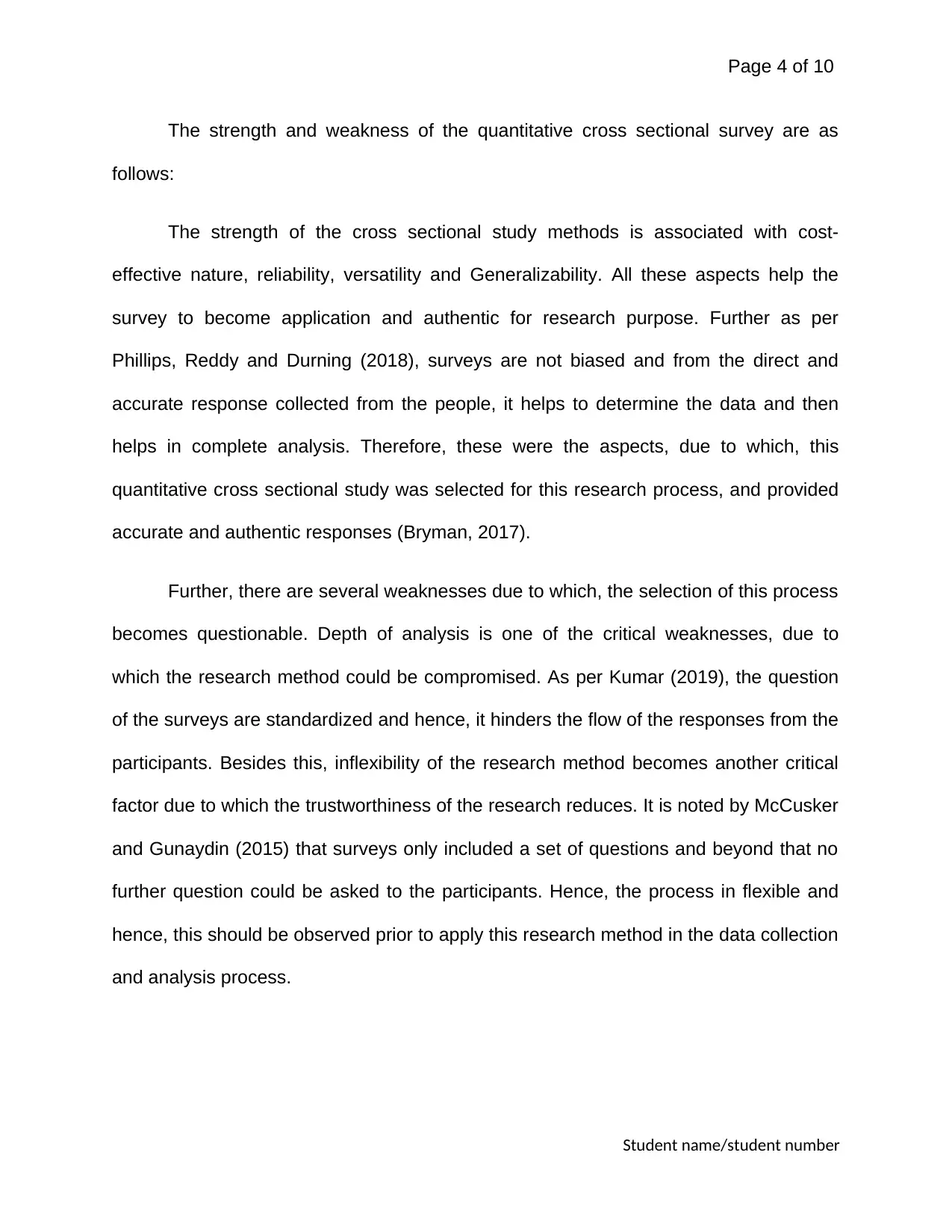
Page 4 of 10
The strength and weakness of the quantitative cross sectional survey are as
follows:
The strength of the cross sectional study methods is associated with cost-
effective nature, reliability, versatility and Generalizability. All these aspects help the
survey to become application and authentic for research purpose. Further as per
Phillips, Reddy and Durning (2018), surveys are not biased and from the direct and
accurate response collected from the people, it helps to determine the data and then
helps in complete analysis. Therefore, these were the aspects, due to which, this
quantitative cross sectional study was selected for this research process, and provided
accurate and authentic responses (Bryman, 2017).
Further, there are several weaknesses due to which, the selection of this process
becomes questionable. Depth of analysis is one of the critical weaknesses, due to
which the research method could be compromised. As per Kumar (2019), the question
of the surveys are standardized and hence, it hinders the flow of the responses from the
participants. Besides this, inflexibility of the research method becomes another critical
factor due to which the trustworthiness of the research reduces. It is noted by McCusker
and Gunaydin (2015) that surveys only included a set of questions and beyond that no
further question could be asked to the participants. Hence, the process in flexible and
hence, this should be observed prior to apply this research method in the data collection
and analysis process.
Student name/student number
The strength and weakness of the quantitative cross sectional survey are as
follows:
The strength of the cross sectional study methods is associated with cost-
effective nature, reliability, versatility and Generalizability. All these aspects help the
survey to become application and authentic for research purpose. Further as per
Phillips, Reddy and Durning (2018), surveys are not biased and from the direct and
accurate response collected from the people, it helps to determine the data and then
helps in complete analysis. Therefore, these were the aspects, due to which, this
quantitative cross sectional study was selected for this research process, and provided
accurate and authentic responses (Bryman, 2017).
Further, there are several weaknesses due to which, the selection of this process
becomes questionable. Depth of analysis is one of the critical weaknesses, due to
which the research method could be compromised. As per Kumar (2019), the question
of the surveys are standardized and hence, it hinders the flow of the responses from the
participants. Besides this, inflexibility of the research method becomes another critical
factor due to which the trustworthiness of the research reduces. It is noted by McCusker
and Gunaydin (2015) that surveys only included a set of questions and beyond that no
further question could be asked to the participants. Hence, the process in flexible and
hence, this should be observed prior to apply this research method in the data collection
and analysis process.
Student name/student number
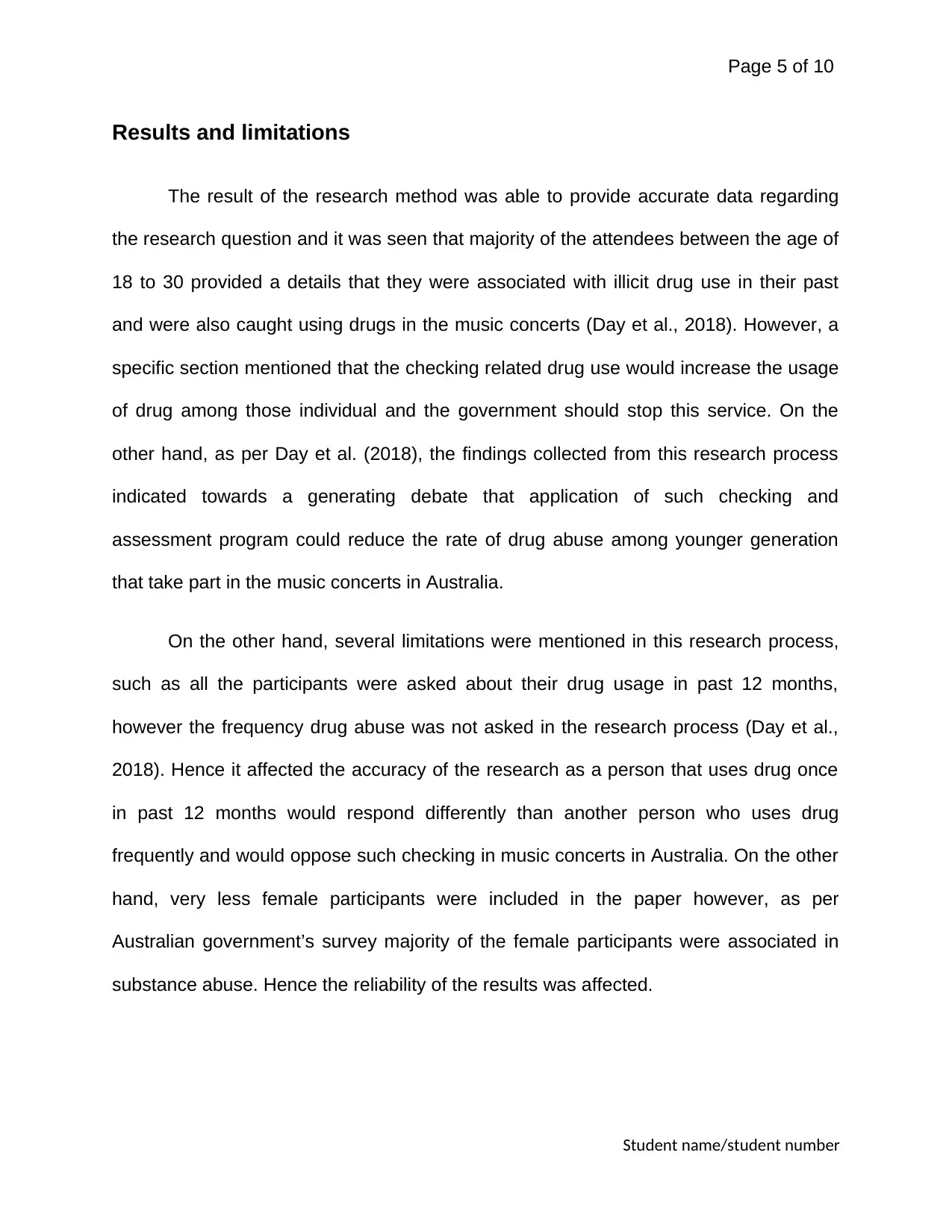
Page 5 of 10
Results and limitations
The result of the research method was able to provide accurate data regarding
the research question and it was seen that majority of the attendees between the age of
18 to 30 provided a details that they were associated with illicit drug use in their past
and were also caught using drugs in the music concerts (Day et al., 2018). However, a
specific section mentioned that the checking related drug use would increase the usage
of drug among those individual and the government should stop this service. On the
other hand, as per Day et al. (2018), the findings collected from this research process
indicated towards a generating debate that application of such checking and
assessment program could reduce the rate of drug abuse among younger generation
that take part in the music concerts in Australia.
On the other hand, several limitations were mentioned in this research process,
such as all the participants were asked about their drug usage in past 12 months,
however the frequency drug abuse was not asked in the research process (Day et al.,
2018). Hence it affected the accuracy of the research as a person that uses drug once
in past 12 months would respond differently than another person who uses drug
frequently and would oppose such checking in music concerts in Australia. On the other
hand, very less female participants were included in the paper however, as per
Australian government’s survey majority of the female participants were associated in
substance abuse. Hence the reliability of the results was affected.
Student name/student number
Results and limitations
The result of the research method was able to provide accurate data regarding
the research question and it was seen that majority of the attendees between the age of
18 to 30 provided a details that they were associated with illicit drug use in their past
and were also caught using drugs in the music concerts (Day et al., 2018). However, a
specific section mentioned that the checking related drug use would increase the usage
of drug among those individual and the government should stop this service. On the
other hand, as per Day et al. (2018), the findings collected from this research process
indicated towards a generating debate that application of such checking and
assessment program could reduce the rate of drug abuse among younger generation
that take part in the music concerts in Australia.
On the other hand, several limitations were mentioned in this research process,
such as all the participants were asked about their drug usage in past 12 months,
however the frequency drug abuse was not asked in the research process (Day et al.,
2018). Hence it affected the accuracy of the research as a person that uses drug once
in past 12 months would respond differently than another person who uses drug
frequently and would oppose such checking in music concerts in Australia. On the other
hand, very less female participants were included in the paper however, as per
Australian government’s survey majority of the female participants were associated in
substance abuse. Hence the reliability of the results was affected.
Student name/student number
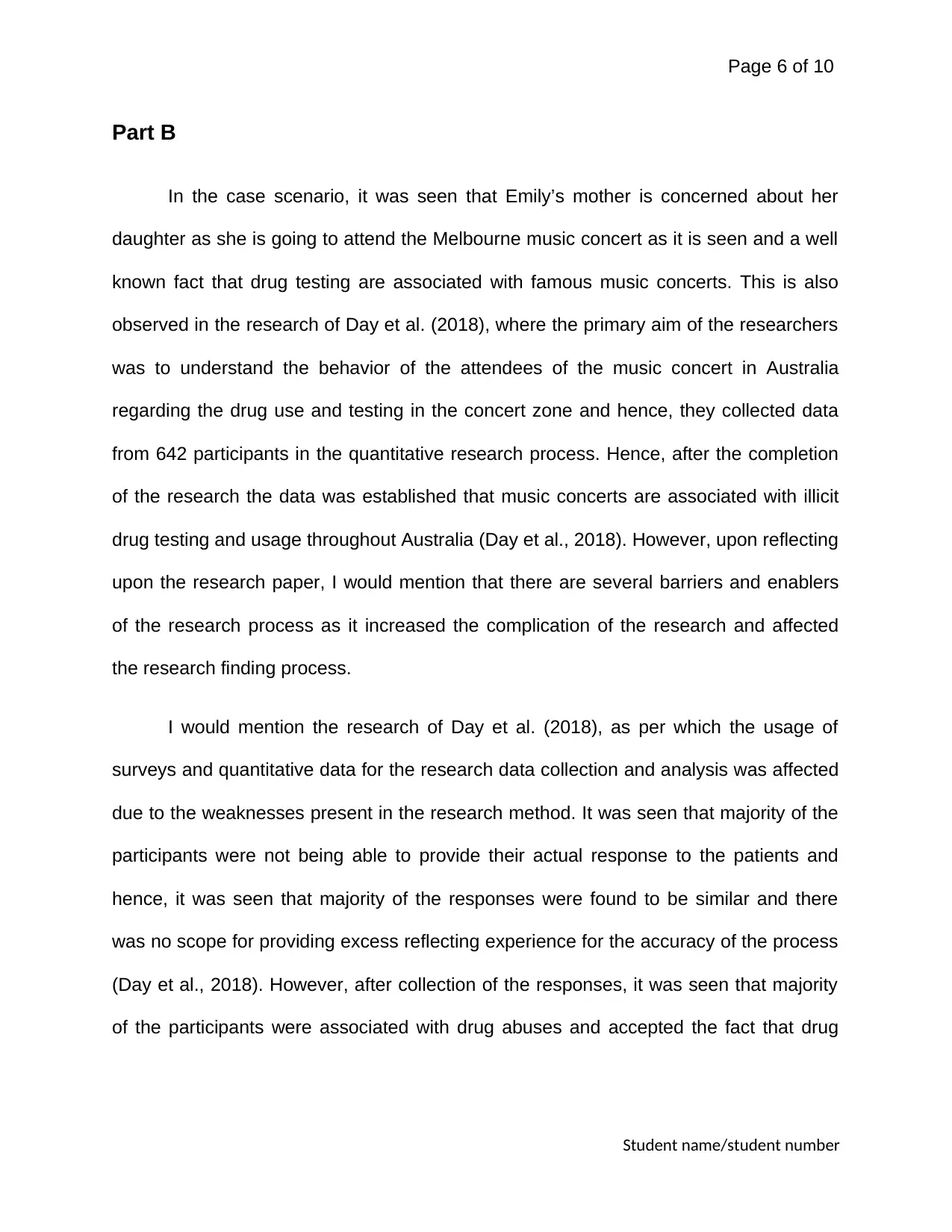
Page 6 of 10
Part B
In the case scenario, it was seen that Emily’s mother is concerned about her
daughter as she is going to attend the Melbourne music concert as it is seen and a well
known fact that drug testing are associated with famous music concerts. This is also
observed in the research of Day et al. (2018), where the primary aim of the researchers
was to understand the behavior of the attendees of the music concert in Australia
regarding the drug use and testing in the concert zone and hence, they collected data
from 642 participants in the quantitative research process. Hence, after the completion
of the research the data was established that music concerts are associated with illicit
drug testing and usage throughout Australia (Day et al., 2018). However, upon reflecting
upon the research paper, I would mention that there are several barriers and enablers
of the research process as it increased the complication of the research and affected
the research finding process.
I would mention the research of Day et al. (2018), as per which the usage of
surveys and quantitative data for the research data collection and analysis was affected
due to the weaknesses present in the research method. It was seen that majority of the
participants were not being able to provide their actual response to the patients and
hence, it was seen that majority of the responses were found to be similar and there
was no scope for providing excess reflecting experience for the accuracy of the process
(Day et al., 2018). However, after collection of the responses, it was seen that majority
of the participants were associated with drug abuses and accepted the fact that drug
Student name/student number
Part B
In the case scenario, it was seen that Emily’s mother is concerned about her
daughter as she is going to attend the Melbourne music concert as it is seen and a well
known fact that drug testing are associated with famous music concerts. This is also
observed in the research of Day et al. (2018), where the primary aim of the researchers
was to understand the behavior of the attendees of the music concert in Australia
regarding the drug use and testing in the concert zone and hence, they collected data
from 642 participants in the quantitative research process. Hence, after the completion
of the research the data was established that music concerts are associated with illicit
drug testing and usage throughout Australia (Day et al., 2018). However, upon reflecting
upon the research paper, I would mention that there are several barriers and enablers
of the research process as it increased the complication of the research and affected
the research finding process.
I would mention the research of Day et al. (2018), as per which the usage of
surveys and quantitative data for the research data collection and analysis was affected
due to the weaknesses present in the research method. It was seen that majority of the
participants were not being able to provide their actual response to the patients and
hence, it was seen that majority of the responses were found to be similar and there
was no scope for providing excess reflecting experience for the accuracy of the process
(Day et al., 2018). However, after collection of the responses, it was seen that majority
of the participants were associated with drug abuses and accepted the fact that drug
Student name/student number
Paraphrase This Document
Need a fresh take? Get an instant paraphrase of this document with our AI Paraphraser
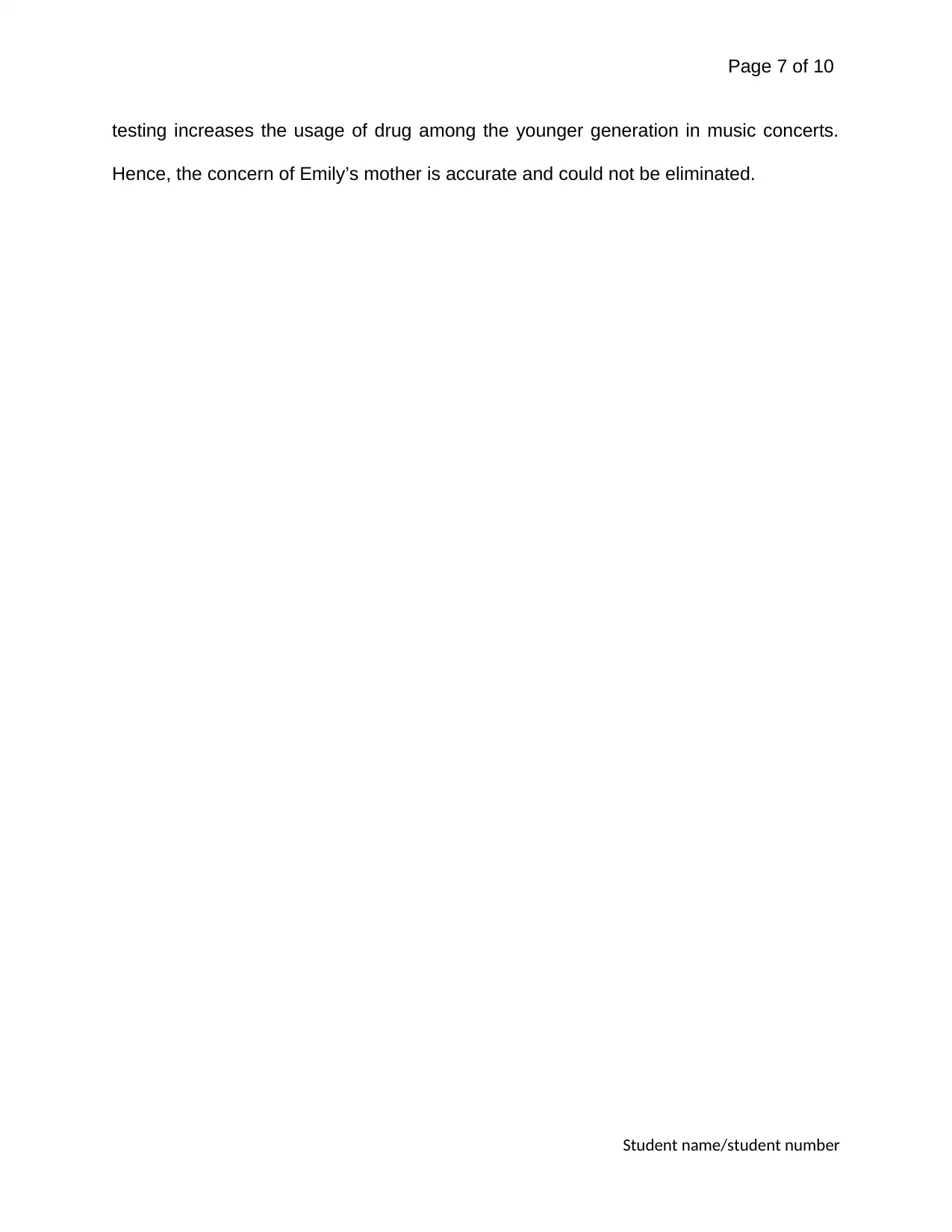
Page 7 of 10
testing increases the usage of drug among the younger generation in music concerts.
Hence, the concern of Emily’s mother is accurate and could not be eliminated.
Student name/student number
testing increases the usage of drug among the younger generation in music concerts.
Hence, the concern of Emily’s mother is accurate and could not be eliminated.
Student name/student number
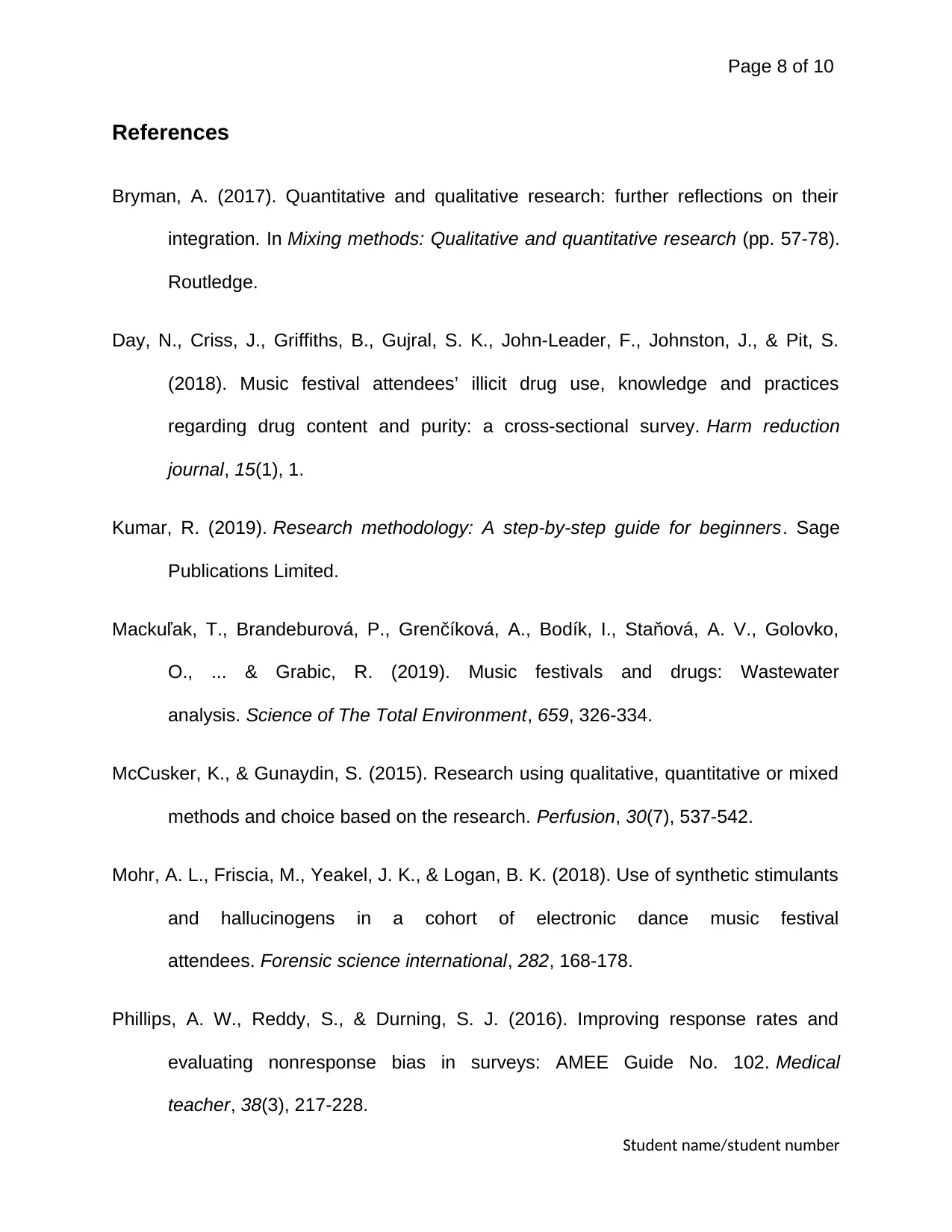
Page 8 of 10
References
Bryman, A. (2017). Quantitative and qualitative research: further reflections on their
integration. In Mixing methods: Qualitative and quantitative research (pp. 57-78).
Routledge.
Day, N., Criss, J., Griffiths, B., Gujral, S. K., John-Leader, F., Johnston, J., & Pit, S.
(2018). Music festival attendees’ illicit drug use, knowledge and practices
regarding drug content and purity: a cross-sectional survey. Harm reduction
journal, 15(1), 1.
Kumar, R. (2019). Research methodology: A step-by-step guide for beginners. Sage
Publications Limited.
Mackuľak, T., Brandeburová, P., Grenčíková, A., Bodík, I., Staňová, A. V., Golovko,
O., ... & Grabic, R. (2019). Music festivals and drugs: Wastewater
analysis. Science of The Total Environment, 659, 326-334.
McCusker, K., & Gunaydin, S. (2015). Research using qualitative, quantitative or mixed
methods and choice based on the research. Perfusion, 30(7), 537-542.
Mohr, A. L., Friscia, M., Yeakel, J. K., & Logan, B. K. (2018). Use of synthetic stimulants
and hallucinogens in a cohort of electronic dance music festival
attendees. Forensic science international, 282, 168-178.
Phillips, A. W., Reddy, S., & Durning, S. J. (2016). Improving response rates and
evaluating nonresponse bias in surveys: AMEE Guide No. 102. Medical
teacher, 38(3), 217-228.
Student name/student number
References
Bryman, A. (2017). Quantitative and qualitative research: further reflections on their
integration. In Mixing methods: Qualitative and quantitative research (pp. 57-78).
Routledge.
Day, N., Criss, J., Griffiths, B., Gujral, S. K., John-Leader, F., Johnston, J., & Pit, S.
(2018). Music festival attendees’ illicit drug use, knowledge and practices
regarding drug content and purity: a cross-sectional survey. Harm reduction
journal, 15(1), 1.
Kumar, R. (2019). Research methodology: A step-by-step guide for beginners. Sage
Publications Limited.
Mackuľak, T., Brandeburová, P., Grenčíková, A., Bodík, I., Staňová, A. V., Golovko,
O., ... & Grabic, R. (2019). Music festivals and drugs: Wastewater
analysis. Science of The Total Environment, 659, 326-334.
McCusker, K., & Gunaydin, S. (2015). Research using qualitative, quantitative or mixed
methods and choice based on the research. Perfusion, 30(7), 537-542.
Mohr, A. L., Friscia, M., Yeakel, J. K., & Logan, B. K. (2018). Use of synthetic stimulants
and hallucinogens in a cohort of electronic dance music festival
attendees. Forensic science international, 282, 168-178.
Phillips, A. W., Reddy, S., & Durning, S. J. (2016). Improving response rates and
evaluating nonresponse bias in surveys: AMEE Guide No. 102. Medical
teacher, 38(3), 217-228.
Student name/student number
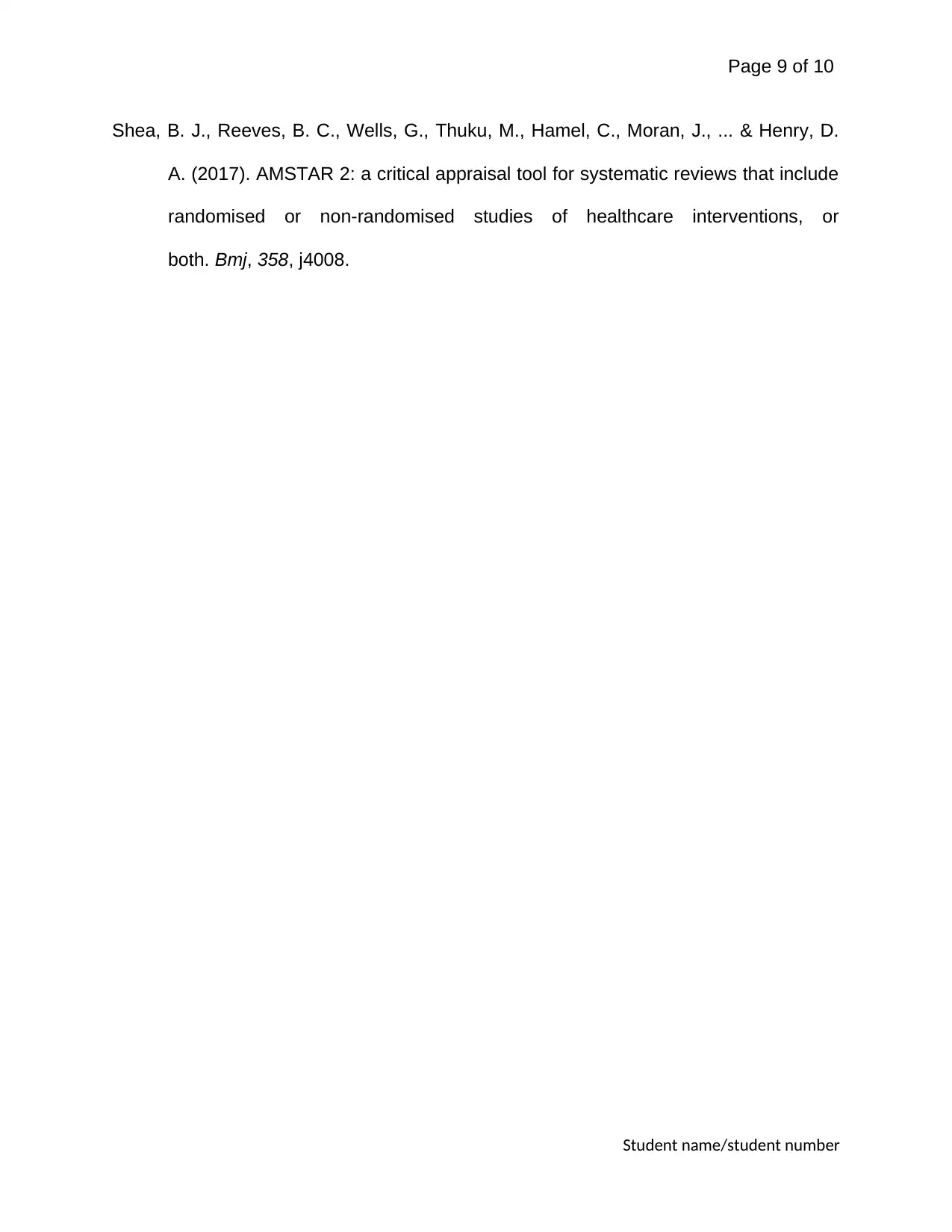
Page 9 of 10
Shea, B. J., Reeves, B. C., Wells, G., Thuku, M., Hamel, C., Moran, J., ... & Henry, D.
A. (2017). AMSTAR 2: a critical appraisal tool for systematic reviews that include
randomised or non-randomised studies of healthcare interventions, or
both. Bmj, 358, j4008.
Student name/student number
Shea, B. J., Reeves, B. C., Wells, G., Thuku, M., Hamel, C., Moran, J., ... & Henry, D.
A. (2017). AMSTAR 2: a critical appraisal tool for systematic reviews that include
randomised or non-randomised studies of healthcare interventions, or
both. Bmj, 358, j4008.
Student name/student number
1 out of 10
Your All-in-One AI-Powered Toolkit for Academic Success.
+13062052269
info@desklib.com
Available 24*7 on WhatsApp / Email
![[object Object]](/_next/static/media/star-bottom.7253800d.svg)
Unlock your academic potential
© 2024 | Zucol Services PVT LTD | All rights reserved.





